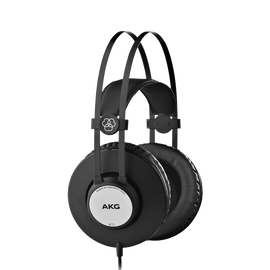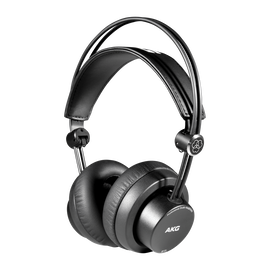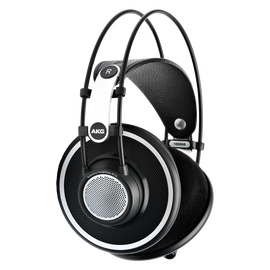
AKG Blog
How to Pick Professional Headphones for Any Scenario
By Sarah jones
What’s your most-used piece of audio gear? You probably don’t need us to tell you that it’s your headphones. Headphones provide a consistent audio reference in a variety of environments, they’re essential tools for evaluating the fine details in your mix—and they do it without annoying the neighbors.
Like studio monitors, headphones are a highly personal choice, and with so many designs and styles out there, finding the perfect match can be challenging. Fear not: Whether you’re mixing, recording, mastering or just listening to your favorite songs, we’re here to help you find a model that perfectly matches your needs and unique audio style.
HEADPHONE STYLES
Headphones are transducers: Just like speakers and microphones, they convert one form of energy (electrical) into another (acoustic energy, or sound). They’re essentially tiny loudspeakers that are based on the same type of driver assembly you’d find in any standard-size speaker. All headphones operate on this basic principle, though their enclosure designs vary according to function.
Over-Ear or On-Ear

AKG’s affordable K72 on-ear, closed-back model offers detail, clarity and long-wearing comfort, thanks to its soft, self-adjusting headband.
Over-ear, or circumaural, headphones, have large, cushioned earpads that are designed to completely surround your ears. Over-ear headphones tend to have a spacious sound and offer more natural imaging than on-ear styles, because their drivers are positioned farther away from the ears so more sound reflects off the outer ear, which replicates the way we hear sound coming from speakers.
Over-ear headphones often feature the largest drivers for deep bass and extended high-frequency response and are available in both open-back and closed-back styles. Over-ear headphones are more comfortable to wear over extended periods than on-ear models, because their earpads surround the outer ear versus pressing directly on it.
If you’re looking for professional-grade headphones on a budget, AKG’s affordable K72 and K92 on-ear, closed-back models offer detail, clarity and long-wearing comfort, thanks to their soft, self-adjusting headbands. For the most demanding critical-listening applications, such as mastering, AKG top-of-the-line K872s feature extra-large 53mm transducers and powerful 1.5 Tesla magnet systems to ensure greatest-in-class headroom and accurate imaging, with a stunning frequency range of 5 Hz–54 kHz.

AKG K175 on-ear headphones have large, 40mm diaphragms and closed backs for best-in-class frequency response and deep, rich low end; and they fold for portability.
On-ear headphones (sometimes called above-ear or supra-aural headphones) have earcups that, you guessed it, sit directly on the ear. These models tend to be lighter and more affordable than over-ear models, making them ideal for mobile lifestyles. AKG K175 on-ear headphones have large, 40mm diaphragms and closed backs for best-in-class frequency response and deep, rich low end; and fold for portability. Because on-ear headphones fit by clamping force, comfort is an important consideration with on-ear models. (The K175s feature a three-axis hinge and self-adjusting headband to ensure a perfect fit.)
Open, Closed or Semi-Open
Closed-back headphones have earcups that are completely sealed at their back (outward-facing) sides. This design offers the most acoustic isolation—both preventing sounds from leaking out and blocking ambient noise from leaking in.
Because of their sound-isolating qualities, closed-back headphones are ideal for tracking because performers can hear their mixes without worrying about sound bleeding into their mic; they’re also great for monitoring and mixing without distractions in noisy environments. (They’re ideal for recording podcasts and voiceovers, for the same reason.)

AKG K361 and K371 closed-back, over-ear models reproduce crisp, detailed audio across an ultra-wide frequency range thanks to their high-sensitivity, largest-in-class 50mm drivers.
Ideal headphones for critical listening include AKG K553 MkII and K361 closed-back, over-ear models, which reproduce crisp, detailed audio across an ultra-wide frequency range thanks to their high-sensitivity, largest-in-class 50mm drivers. The K371’s titanium drivers go even further, delivering an extended frequency response from 5 Hz to 40 kHz and matching AKG’s Reference Response acoustic targets to reproduce natural, balanced audio exactly as intended.
Beyond studio uses, closed-back headphones are perfect for casual listening, listening at the office, and commuting. Because closed-back headphones tend to have pronounced bass response, they’re favored by DJs.

AKG K701 and K702 open-back, over-ear headphones feature AKG’s patented Varimotion two-layer diaphragm, which delivers extended highs and an improved low end.
Open-back headphones have vented backs that allow air to pass through, letting sound in and out and improving airflow to provide what many consider a wide, airy soundstage. They offer a natural, spacious feeling that makes them ideal for critical listening, mixing and working with high-resolution audio files, but because they don’t offer the isolation of closed-back models, they’re best used in quiet, private situations where you won’t be distracted by the sounds around you (or annoy others with the sound bleeding from them). AKG K245 open-back, over-ear headphones feature 50mm transducers—the largest in their class—for greater low-frequency extension and crisp, detailed bass reproduction. Other great choices include AKG K701 and K702 open-back, over-ear headphones, which feature AKG’s patented Varimotion two-layer diaphragm design for extended highs and an improved low end.

AKG K240 Studio semi-open, over-ear headphones are modern versions of AKG’s iconic 1970s studio headphones.
Semi-open-back headphones fall somewhere between fully open and closed-back designs. Because the driver is not completely sealed, some air can pass through, which gives this style some of the attributes of an open-back headphone, such as a natural, realistic soundstage and extended frequency response, with less leakage than a true open-back design. Semi-open-back headphones are great choices for recording without open microphones, mixing, casual listening and listening at home. AKG K240 Studio semi-open, over-ear headphones are modern versions of AKG’s iconic 1970s studio headphones; K240 MkII headphones feature upgraded ear pads and an additional cable.

AKG K361-BT and K371-BT feature built-in mics and audio playback and telephone call controls. Plus, it’s a great idea to reference your mixes over Bluetooth to ensure they translate to any format.
Other Considerations
Bluetooth technology has made great strides in recent years, and today’s premium Bluetooth headphones offer sound quality nearly indistinguishable from their wired versions. Low latency and the ability to stream high-res audio files mean you no longer have to sacrifice convenience for performance. For the multitaskers out there, some Bluetooth headphones, such as the AKG K361-BT and K371-BT, feature built-in mics and audio playback and telephone call controls. It’s a great idea to reference your mixes over Bluetooth to ensure they translate to any format. You’ll want to keep an eye on battery life; but just about every pair ships with cables, to ensure you can keep on listening.

In addition to large 50 mm transducers and a closed-back, over-ear design, the road-tough AKG K275 headphones feature rugged metal components for extra durability.
Comfort, Portability and Durability
Certainly, sound quality is your top consideration. When you’re trying on headphones, think about how they sound, and also how they feel—after all, you’ll be wearing them every day. Weight is a factor in comfort; larger, more durable headphones tend to be heavier than lightweight, flimsy models. Look for models that are light for their size, with cushioned earcups. (Some people find that oval headphones, such as the AKG K361 and K371, provide a more comfortable fit than round models; this is purely personal preference.)
If portability is important, look for folding models such as the AKG K361, a K371 and K553 MkII, which feature 50mm drivers for precise, expanded frequency response and extra-soft earpads for comfort during long sessions. Look for sturdy hinges and other moving parts; AKG’s road-tough K175, K245 and K275, for example, feature rugged metal components for extra durability. Ideally, your headphones will have replaceable parts; it costs a lot less to replace earpads and cables than to buy new headphones.
UNDERSTANDING THE SPECS
Like any audio gear, headphones can be defined by specs—but you should never rely on specs alone to judge quality. Although some specs can be helpful, taking them out of content can be confusing. That said, here are a few important specs to watch:
Frequency Response: This will tell you the range of sound your headphones are capable of producing. Although humans hear from 20 Hz to 20 kHz, most experts agree that we can sense sounds outside of that range, and products with a wider frequency response often perform better within that human hearing range. Headphone frequency-response curves are designed to be flat or “colored”—enhanced at certain frequencies to make them sound more appealing (for example, adding bass boost). Although sound is a matter of preference, neutral headphones will provide a much more accurate sonic translation, which is crucial when evaluating mixes or other critical-listening scenarios.

AKG’s flagship K872 headphones feature extra-large 53mm transducers and powerful 1.5 Tesla magnet systems to ensure greatest-in-class headroom and accurate imaging, with a stunning frequency range of 5 Hz–54 kHz.
Impedance: When electric current flows through a circuit, it encounters resistance, which is defined as impedance, expressed in ohms (Ω). The lower a headphone’s impedance, the less power it needs to deliver high audio levels. For maximum power transfer, headphone impedance should match source output impedance, though power loss in unmatched gear is common and isn’t necessarily a deal breaker. (A headphone amplifier is one way to overcome the effect of unmatched impedances.) In general, studio headphones have high impedance (which allows multiple units to be powered by a splitter or amplifier for, say, a band session); low-impedance headphones (below around 50 ohms) work well with phones and other devices that output low voltage and current.
Sensitivity: Headphone sensitivity, usually expressed in decibels, measures how efficient a headphone’s drivers are at turning an electrical signal into sound. In other words, it tells you how much volume headphones will produce from a given amount of power. Everything else being equal, headphones with higher sensitivity will produce louder sounds than headphones with lower sensitivity.
THE FINAL VERDICT
At the end of the day, headphone choice is entirely subjective. Sound quality aside, the most important consideration is how you’ll be using the headphones. Spend some time thinking about the ways you make music and learn which styles are best for those scenarios. (With so many styles available, you might even consider getting a few pairs for different uses.)
Then, it’s just a matter of researching your options and taking the finalists for a spin. (With free shipping and returns from AKG.com, we make that easy.) Pretty soon, you’ll be unveiling more detail in your music, making better mix decisions and getting lost in that amazing sound.

Related products
AKG Blogs
9 pro tips for livestreaming your show from home
If you’re like most musicians, gigs are your lifeblood. But when you can’t connect with your audience in person, livestreaming is your best opportunity to gain new fans and generate income while building momentum for your next show.
Read MoreHow to Pick Professional Headphones for Any Scenario
What’s your most-used piece of audio gear? You probably don’t need us to tell you that it’s your headphones. Headphones provide a consistent audio reference in a variety of environments, they’re essential tools for evaluating the fine details in your mix—and they do it without annoying the neighbors.
Read MoreComparing digital & analog wireless mic systems
Since the release of AKG’s new DMS 100 and DMS 300 digital wireless systems, we’ve fielded lots of questions about the differences between digital and analog systems, so we thought it would be helpful to explain the benefits of each.
Read MoreHow to choose the right microphone to record anything
Choosing the right mic is more art than science, and involves trial and error. Getting to know the “sound” of the mics you own and learning how they perform in different scenarios are the first steps toward making professional-sounding recordings at home.
Read MorePro sound for work-at-home professionals
Whether your home office or classroom is temporary or permanent, HARMAN has affordable, easy-to-use tools that will help you communicate with clarity and focus on the task at hand.
Read More7 ways to sound better on a conference call
Conferencing services like Zoom, Skype and Webex bring familiar faces right to your screen—and chances are, conference calls are becoming a central part of your life right now.
Read MoreHow to get studio-quality sound from your smartphone with AKG Lyra
Whether you’re recording a podcast or voiceover, making field recordings, capturing audio inspiration on the go, or live streaming to your fans, nothing beats the convenience and portability of a smartphone.
Read MoreAKG DMS300 Digital Wireless Systems Earn High Praise from Performer Magazine
Wireless microphone systems have come a long way over the years, and the AKG DMS300 digital system is no exception. Once thought of as inferior to their wired counterparts, many wireless systems like DMS300 not only sound just as good—if not better—than wired systems.
Read More


















